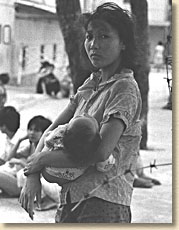 |
|||||
| Line-ups for food, line-ups for water, line-ups to use the facilities: such was the reality of Asian refugee camps. The refugees were often confined to the camps and, with no possibility of shopping for food and supplies beyond its limits, a thriving black-market trade developed, with the help of the local population.
Entire families were crammed into minimal accommodation, often not more than 1 or 2 square metres in size. Many of the camps were little more than gigantic prisons. Living conditions were more reasonable in camps that were supervised by the United Nations High Commissioner for Refugees (UNHCR).
The refugee camps soon became overcrowded and new arrivals were refused entry to the camps and the country. They were given supplies of food, water and fuel, and then towed back out to sea. In desperation, some refugees sank their boats at night in order to force the local authorities to accept them. Others had to remain on board the boats for several months before they were allowed to disembark.
|
|||||
 |
 |
 |
|||
|
|
|||||
| Menu | At the Museum Discover Vietnam | History of Vietnam | Leaving Vietnam | In Canada More Information | Index | Credits |
|||||
|
|
|||||

